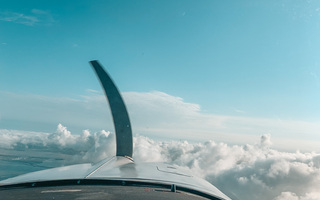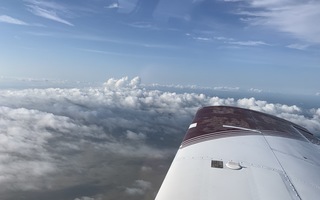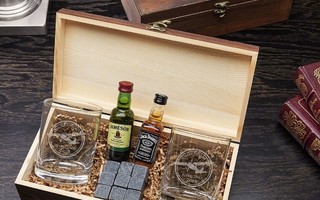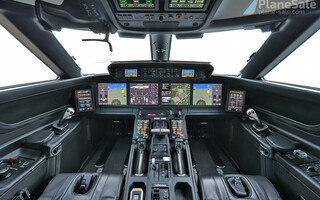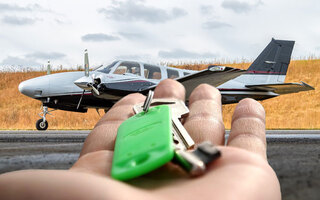Business jets have created a world of opportunity for businesses and high wealth individuals around the world, allowing them the ability to fly themselves or send predominant staff to places that commercial flights can’t reach. They allowed these executives to attend imperative meetings and be home for dinner. The social status of owners increased as well, showcasing to others that they were long on financial resources and short on time.
The following are four aircraft that changed the world in regards to time efficiency, business productivity, and social status. What is most interesting is that all four originated from military contracts with the intent of being quicker and more efficient than predecessors.
Lockheed created the L-329 as a private venture to meet a United States Air Force (USAF) requirement, which ultimately shaped it into the world’s first business jet design.
The JetStar was one of the largest aircraft in its class, seating ten plus two crew. It was the first corporate aircraft to allow a person to walk upright in the cabin. It can be distinguished from other small jets by its four engines, which are mounted at the tail and the “slipper” style fuel tanks fixed to the wings to accommodate the increased fuel consumption from two extra engines.
Although it was not the primary Air Force One aircraft, VC-140B’s did carry Presidents Lyndon B. Johnson, Richard Nixon, Gerald Ford, Jimmy Carter, and Ronald Reagan while they were in office and used the Air Force One call sign while aboard.
Elvis Presley owned two JetStars at different times, the second being known as Hound Dog II. Reportedly he paid $899,702.60 for the aircraft on September 2, 1975.
The Sabreliner was developed in the mid-1950s by Los Angeles-based North American Aviation as an in-house project. North American offered a military version to the USAF in response to the Utility Trainer Experimental (UTX) program. Because no other companies competed for the UTX, North American Aviation won the contract by default.
This was the world’s first executive aircraft to run on a twin-jet system. It was named Sabreliner due to its similarity of supercritical and swept wings and tail to the North American F-86 Sabre jet fighter. It also included innovational slats.
Over 800 Sabreliners were produced, 200 of which were T-39s, military variants used by the USAF, United States Navy, and United States Marine Corps. Deriving itself from the F-86 Sabre, the Sabreliner is the only business jet authorized for aerobatics. The cockpit windows had topside “eyebrows” that provided a distinctive recognition feature for the aircraft.
Sabreliner was sold to Rockwell International and renamed as the Rockwell Sabreliner. In 1981, Sabreliner production came to a close. In 1982, Rockwell sold the Sabreliner division to a private equity firm which later formed Sabreliner Corporation.
Among the first, and best known, private jets was the Lear Jet 23 (later renamed Learjet). This jet’s small size and economically fast operation made it a staple in the fleet of captains of industry, celebrities, and other wealthy members of society across the world.
The Lockheed JetStar and North American Sabreliner had been on the market before the Learjet 23 was produced, but its ability to climb higher and faster than its competitors made it the first civilian, jet-powered light aircraft.
The aircraft was beyond its time in terms of performance: 518 MPH cruising speed, 562 MPH (488 knots) maximum speed, 6,900 feet-per-minute rate of climb, 1,830-mile range, and 45,000-foot ceiling. According to the Smithsonian Institution, the Model 23 could out-climb an F-100 Super Sabre to 10,000 ft.
The man behind the Learjet was William “Bill” Powell Lear, Sr., who was inspired by the Swiss P-16 fighter jet prototype. Lear established the Swiss American Aviation Corporation (SAAC) to produce the passenger version: the SAAC-23 ExecuJet. After moving the company to Wichita, Kansas, he renamed it the Lear Jet Corporation.
Essentially, Bill Lear wanted a small aircraft that could perform like a jet airliner and carry its five passengers and two pilots at 500 MPH for distances of 1,500 miles or more. While the aircraft performed like a fighter, it also had the accident record of one. The Model 23 was demanding to fly, even for experienced pilots. It was unrelenting of pilot errors, leading to 23 Learjet crashes in only three years with four of those resulting in fatalities. The fleet was only made of 104 aircraft, meaning you had a 22% chance of crashing each time you flew in one.
Lear recognized the problem and introduced the Model 24 in 1966, with improved two-speed handling qualities. The accident rates improved as new models continued to be put on the market, but these rates were still much higher than other corporate jets of the time.
In December of 1961, French aircraft designer and head of Dassault Aviation, Marcel Dassault, provided the approval to work towards the production of an eight to ten seat executive jet/military liaison aircraft that could fly 500 mph+, which was initially named the Dassault-Breguet Mystère 20.
This low-wing monoplane drew upon the aerodynamics of the transonic Dassault Mystère IV fighter-bomber and was equipped with a pair of rear-mounted Pratt & Whitney JT12A-8 turbojet engines. Later upgrades to the airframe include Garrett TFE-731 engines.
Directly selling the aircraft wasn’t a viable option, so they settled on Pan American World Airways as the US distributor. The aircraft were distributed in America under the name Fan Jet Falcon, later becoming popularly known as the Falcon 20. In total, Pan American placed orders for a combined total of 160 Falcon 20s. Other major orders were soon placed by several operators, both civil and military; amongst these included the French Navy, the United States Coast Guard, and Federal Express.
During the late 1960s and early 70s, aviation businessman Frederick W. Smith was seeking an ideal aircraft with which to launch his new business, Federal Express, commonly known today as FedEx. The Falcon 20 had a strong fuselage, making it the ideal aircraft for cargo operations. The first packages to be carried by FedEx were in a Falcon 20 on April 17, 1973. Within a decade, the company was using 33 of the twinjets in its air express network.
Dassault went on to sell more than 500 Falcon series aircraft until 1991. The French company continues to be a major player in the market today with its lineup of twin- and three-engined designs.
These private jets began as ideas on a crumpled piece of paper in the corner of a desk. No one could have known just how impactful they would become. Across the world, they represent wealth and power to socialites and business owners alike. It is because of these aircraft that the private jet industry is stronger today than ever before.
